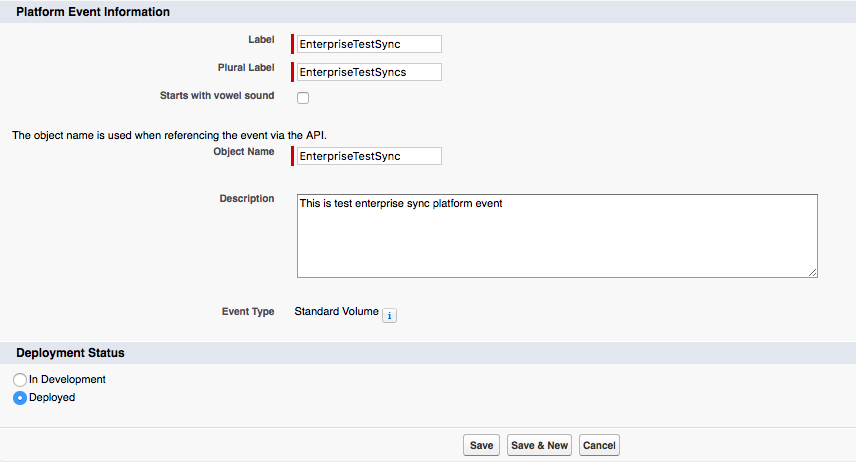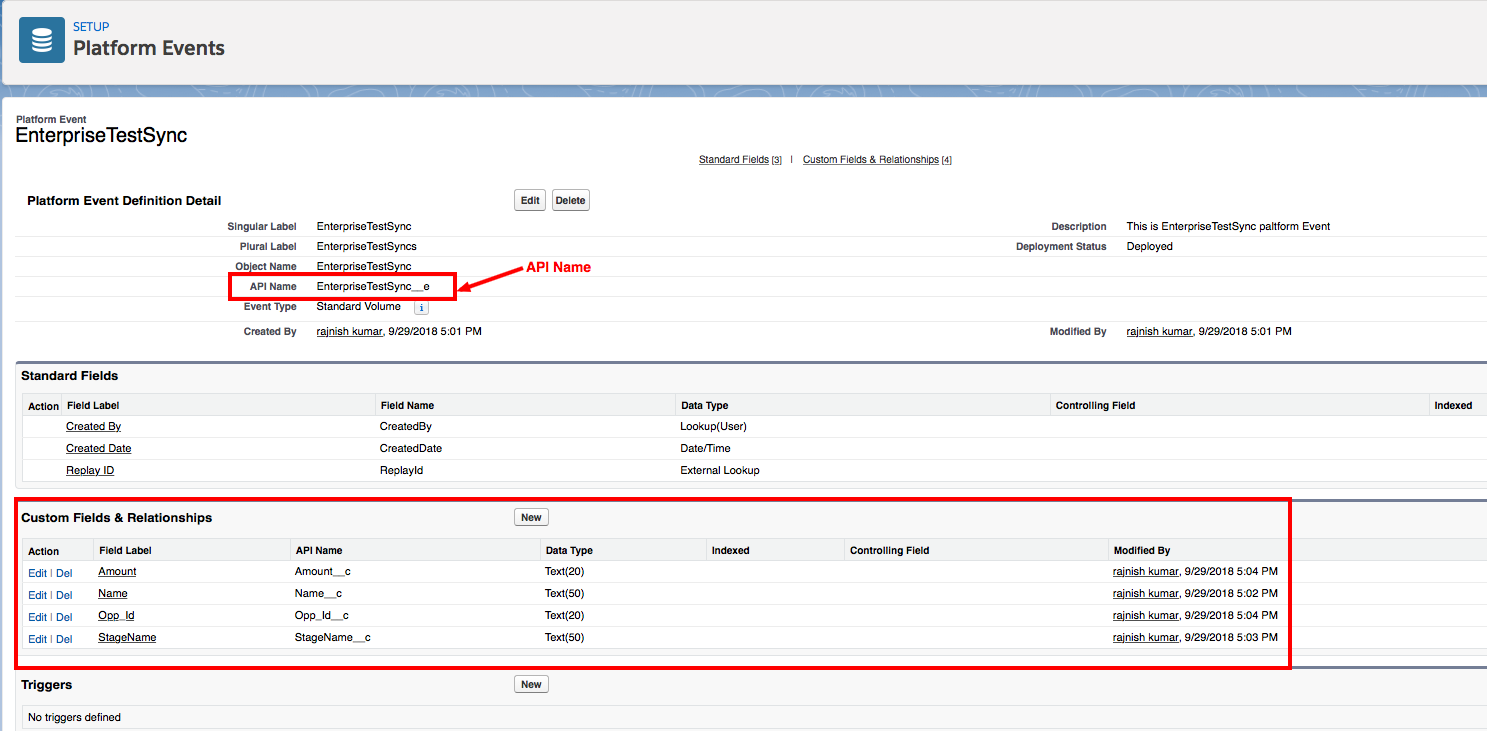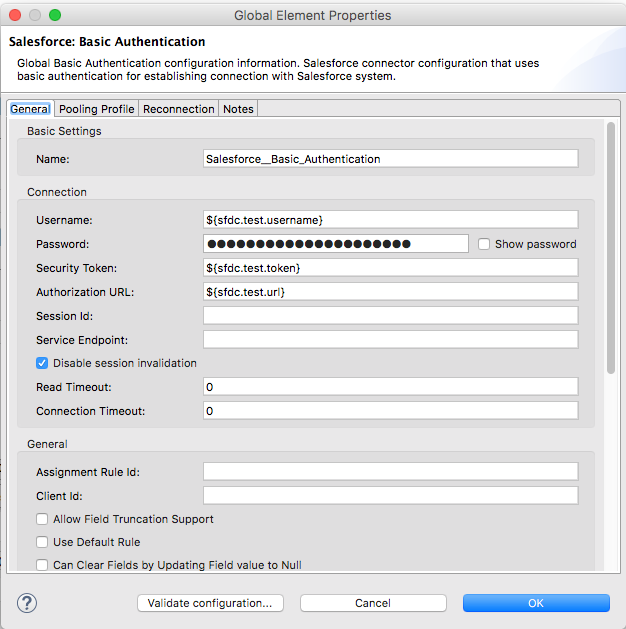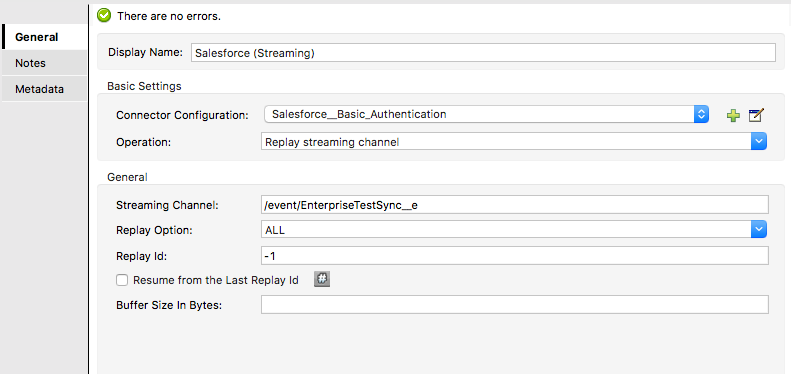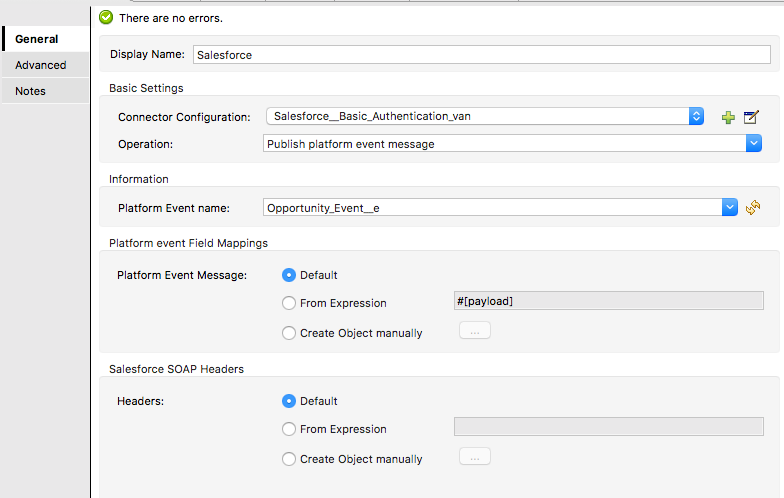Summer 2017 Salesforce released new event-driven architect “Platform Events” feature. Salesforce is known for its custom metadata platform, and now it is delivering a custom messaging platform, so Salesforce customers can build and publish their own events. Platform Events enables customer to increase business productivity and efficiency through integration via event. This feature reduces point-to-point integration and expands the existing capability with more integration options like Outbound Messaging, Apex Callouts, and the Streaming API. With platform events, there are two parties to the communication: a sender and a receiver. They are two of the components of an event-driven architecture.
Before going any further, let’s define some of terminology of platform event.
Event — A change in state that is meaningful in a business process. For example, if opportunities are created or updated in salesforce, this action will generate event within salesforce.
Event message – An event message is payload of event. For example, events are generated after creating or updating opportunities. So, this event has all updated data or updated delta of data which comes as payload.
Event producer – Publishing event with event message is event producer. For example, publish opportunities payload after generating event for other system.
Event channel — A stream of events on which an event producer sends event messages and event consumers read those messages.
Event consumer — A subscriber/Event consumer is an event channel that receives messages from the Event Bus. For example, Application which is subscribing event channel to process further is event consumer.
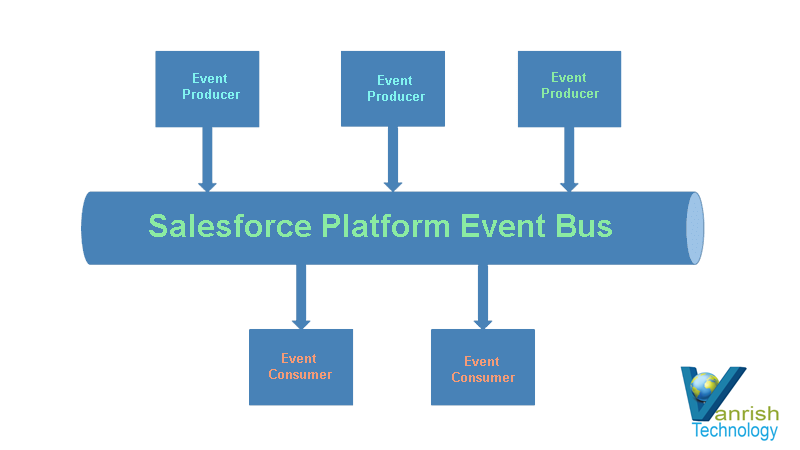 Event-based software architecture
Event-based software architecture
Set Up Platform Events in Salesforce
- On the Salesforce page, click the Setup icon in the top-right navigation menu and select Setup.
- Enter Platform Events into the Quick Find box and then select Data > Platform Events.
- Click New Platform Event.
- In the New Platform Event form, please fill all form
- Click Save
- It will be redirected to the EnterpriseTestSync Platform Event page. By default, it creates some standard fields.
- Now you need to create Custom Platform Event fields that correspond to your EnterpriseTestSync. In the Custom Fields & Relationships section, click New to create a field for EnterpriseTestSync.
- Make sure that the Enterprise Test Sync API Name is EnterpriseTestSync__e and that Custom Fields & Relationships looks like this.
- If you have any trigger for platform event you can create in trigger section.
- Click Save.
Save action will create platform event in salesforce. In next section create Mulesoft integration flow
Integration Mulesoft and Plateform Event
To Integrate with Salesforce Platform Events, please download Mulesoft Salesforce connector v8.4.0 or beyond from Anypoint Exchange.
In my example, I am creating application which syncs salesforce opportunity between two salesforce instances. So, any create or update opportunity will create platform event in salesforce instance. This platform event is subscribed by Mulesoft Salesforce platform event connector in first salesforce instance. Mulesoft receives platform event and platform message from first salesforce instance. Mulesoft transforms this platform message into another format of message and publishes into other salesforce platform event. Platform event can be tracked by replay id. Replay id is unique field when Salesforce generates any platform event. Platform event message persist only 24 hrs in platform Event Bus. We can replay this message within 24hrs.
Here are the steps for Mulesoft integration with Salesforce platform event and flow to communicate between two Salesforce platform event.
- Please configure Salesforce Basic Authentication from global element in Anypoint studio.
-
- Configure Salesforce connector for platform event which listen Salesforce platform event from event channel.
- Select operation as “Replay streaming channel”
- Streaming Channel: Add “/event/EnterpriseTestSync__e”. “EnterpriseTestSync__e” is API name from Salesforce platform event. This API listen event with /event/
- Replay option: There are 3 options
- ALL – This option replays all message from event channel
- FROM_REPLAY_ID – This option replays only specific event message replay Id
- ONLY_NEW – This option replay only new event messages from channel.
- Configure Salesforce connector for platform event which listen Salesforce platform event from event channel.
- Once it is configured, it is ready to accept event message from platform event Channel. Add transformation logic to publish platform event into other Salesforce instances.
- Configure Salesforce platform event for publish event message into
-
- Once you configure these ends point application is ready to listen Event from first instance of Salesforce Platform event and publish platform event into other instance of Salesforce.

Mulesoft – Salesforce platform event flow Here is flow of this application
- Here is code of this application
<?xml version="1.0" encoding="UTF-8"?>
<mule xmlns:tracking="https://www.mulesoft.org/schema/mule/ee/tracking"
xmlns:dw="https://www.mulesoft.org/schema/mule/ee/dw"
xmlns:sfdc="https://www.mulesoft.org/schema/mule/sfdc"
xmlns="https://www.mulesoft.org/schema/mule/core"
xmlns:doc="https://www.mulesoft.org/schema/mule/documentation"
xmlns:spring="https://www.springframework.org/schema/beans"
xmlns:xsi="https://www.w3.org/2001/XMLSchema-instance"
xsi:schemaLocation="https://www.mulesoft.org/schema/mule/ee/dw https://www.mulesoft.org/schema/mule/ee/dw/current/dw.xsd
https://www.springframework.org/schema/beans https://www.springframework.org/schema/beans/spring-beans-current.xsd
https://www.mulesoft.org/schema/mule/core https://www.mulesoft.org/schema/mule/core/current/mule.xsd
https://www.mulesoft.org/schema/mule/sfdc https://www.mulesoft.org/schema/mule/sfdc/current/mule-sfdc.xsd
https://www.mulesoft.org/schema/mule/ee/tracking https://www.mulesoft.org/schema/mule/ee/tracking/current/mule-tracking-ee.xsd">
<flow name="bu-vanrish-eventFlow">
<sfdc:replay-streaming-channel config-ref="Salesforce__Basic_Authentication" streamingChannel="/event/EnterpriseTestSync__e" replayOption="ALL" replayId="-1" doc:name="Salesforce (Streaming)"/>
<logger message="Before Transformation -- #[payload]" level="INFO" doc:name="Logger"/>
<dw:transform-message doc:name="Transform Message">
<dw:set-payload><![CDATA[%dw 1.0
%output application/java
---
{
Name__c: payload.payload.Name__c,
StageName__c:payload.payload.StageName__c,
CreatedById:payload.payload.CreatedById,
Amount__c:payload.payload.Amount__c,
Opp_ID__c:payload.payload.Opp_ID__c
}]]></dw:set-payload>
</dw:transform-message>
<logger message="After transformation -- #[payload]" level="INFO" doc:name="Logger"/>
<sfdc:publish-platform-event-message config-ref="Salesforce__Basic_Authentication_van" platformEventName="Opportunity_Event__e" doc:name="Salesforce"/>
<logger message="BU Vanrish complete flow-- #[payload]" level="INFO" doc:name="Logger"/>
</flow>
</mule>Rajnish Kumar, the CTO of Vanrish Technology, brings over 25 years of experience across various industries and technologies. He has been recognized with the “AI Advocate and MuleSoft Community Influencer Award” from the Salesforce/MuleSoft Community, showcasing his dedication to advancing technology. Rajnish is actively involved as a MuleSoft Mentor/Meetup leader, demonstrating his commitment to sharing knowledge and fostering growth in the tech community.
His passion for innovation shines through in his work, particularly in cutting-edge areas such as APIs, the Internet Of Things (IOT), Artificial Intelligence (AI) ecosystem, and Cybersecurity. Rajnish actively engages with audiences on platforms like Salesforce Dreamforce, World Tour, Podcasts, and other avenues, where he shares his insights and expertise to assist customers on their digital transformation journey.




